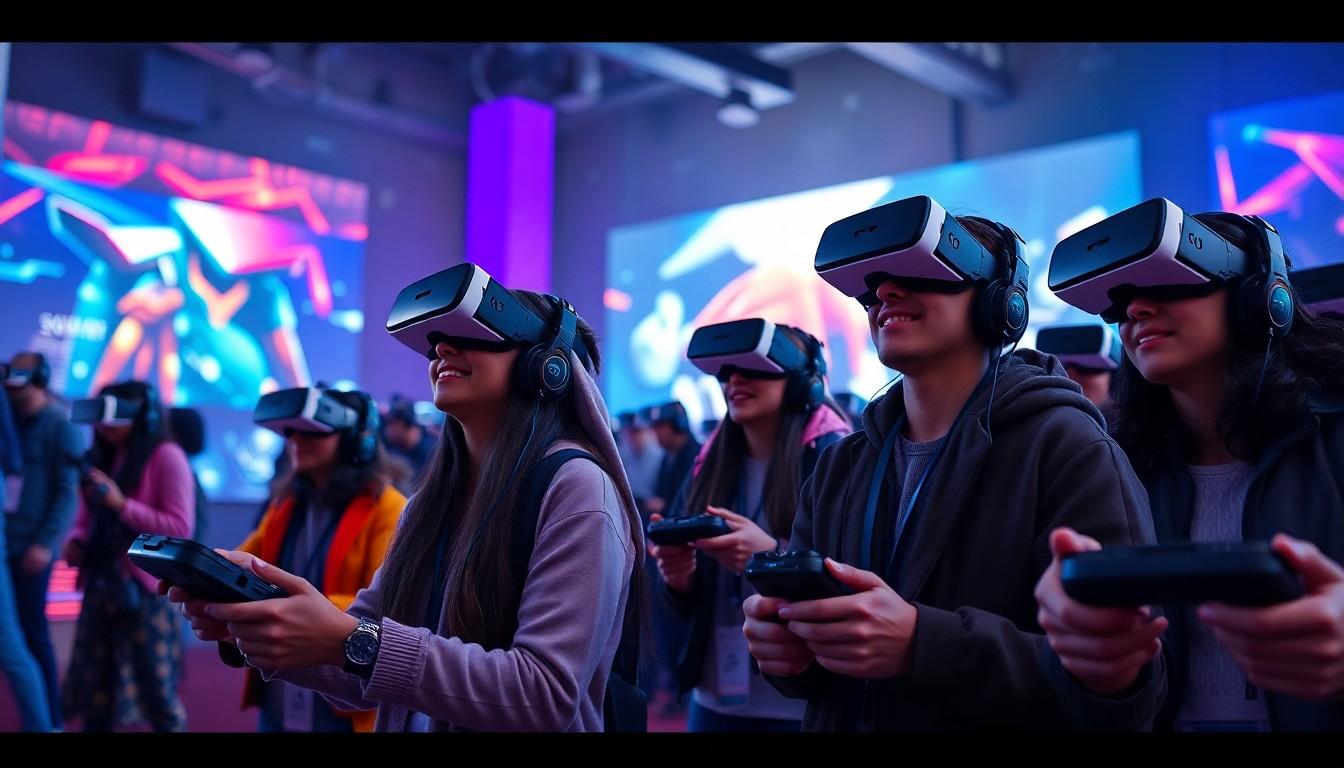In a world where reality sometimes feels overrated, virtual games whisk players away to fantastical realms where dragons roam and alien worlds await. Ever wondered how these digital playgrounds come to life? It’s not magic—though it might feel that way when you’re dodging fireballs or solving intricate puzzles.
How Virtual Games Work
Virtual games immerse players in engaging environments, utilizing advanced technology to create interactive experiences. Graphics generate lifelike visuals, enabling users to feel as if they are part of the game world. Audio design enhances realism with sound effects and music, providing depth to gameplay.
Game engines serve as the backbone, powering the creation of these digital adventures. Unity and Unreal Engine are popular choices, providing developers with robust tools to build dynamic worlds. Code controls character movements and interactions, establishing rules and mechanics that govern gameplay.
Multiplayer capabilities connect players across various locations. Online servers facilitate real-time communication, allowing users to collaborate or compete in expansive arenas. Each player can engage with others, creating a social aspect that enhances the gaming experience.
Virtual reality (VR) technology elevates the gaming landscape by incorporating headsets and motion tracking. This equipment enables users to engage with their surroundings naturally, blurring the line between the real and virtual worlds. Players can physically move and interact within the game environment, increasing immersion.
In-game economies often simulate real-world transactions, allowing players to buy, sell, and trade virtual items. Currency can be earned through gameplay or purchased, creating a dynamic marketplace. This aspect encourages strategy and resource management, adding layers to the gaming experience.
Regular updates keep content fresh and engaging. Developers often release new features, challenges, or expansions, ensuring that players remain invested. The constant evolution of virtual games keeps users returning, eager to explore what’s next.
Key Components Of Virtual Games

Virtual games rely on several critical components that shape the overall experience for players.
Game Engine
Game engines act as the core framework for developers, providing the tools needed to design interactive environments. Unity and Unreal Engine represent two of the most popular engines, each offering unique capabilities. They enable developers to create complex worlds by managing graphics, physics, and audio effectively. Functionality includes character movement and environmental interactions, ensuring seamless gameplay. Developers utilize scripting languages within these engines to implement game logic, enhancing user engagement. Customization options allow for diverse game styles, catering to various player preferences. These engines essentially serve as the foundation upon which virtual adventures are built, connecting creativity with technical execution.
Graphics and Sound Design
Graphics and sound design contribute significantly to immersion in virtual games. High-quality visuals create realistic environments, drawing players deeper into the experience. Detailed textures, dynamic lighting, and fluid animations elevate the overall aesthetic, making settings more engaging. Sound design complements visuals through immersive audio effects and thematic music, creating a rich atmosphere. Background sounds enhance the sense of presence, while sound cues provide feedback on player actions. Together, graphics and sound design form a cohesive sensory experience that captivates players, encouraging longer play sessions. Engaging visual and auditory elements are essential for making virtual games memorable and enjoyable.
Mechanics Behind Gameplay
Understanding the mechanics behind gameplay reveals how virtual games engage players. Multiple systems work cohesively to create a seamless experience.
User Input and Interaction
User input significantly drives gameplay mechanics. Players utilize controllers, keyboards, or other input devices to execute commands. Actions such as jumping, shooting, or navigating happen in real time. Game responsiveness relies on user feedback, enhancing immersion and enjoyment. Developers design intuitive controls, enabling players to connect with virtual environments smoothly. Interfaces often provide visual cues to guide users and enhance interaction. This design enables players to develop strategies based on their experiences.
Game Physics and AI
Game physics create a believable environment, simulating how objects interact within the virtual world. Gravity, friction, and collisions mimic real-world behavior, enhancing player immersion. Advanced physics engines ensure objects respond realistically, affecting player strategies. Artificial intelligence governs non-player characters (NPCs), providing dynamic challenges and realistic behaviors. NPCs often learn from player actions, offering unique experiences in each gameplay session. The combination of physics and AI fosters engaging scenarios that keep players returning for more. These elements work together, making virtual games not only entertaining but also intellectually stimulating.
Online Multiplayer Dynamics
Online multiplayer games create vibrant experiences through interconnected networks and engaging gameplay mechanics.
Network Architecture
Network architecture comprises various elements essential for online interactions. Servers serve as hubs where players connect, facilitating seamless communication. Peer-to-peer connections allow players to interact directly, enhancing speed and reducing latency. Infrastructure ensures a stable experience by managing data transmission between users globally. Cloud gaming solutions enable access to games without hefty hardware, expanding reach and convenience. Advanced protocols optimize data transfer, ensuring smooth real-time gameplay. Scalability is crucial; it enables platforms to accommodate increasing user bases without compromising performance.
Matchmaking Systems
Matchmaking systems play a pivotal role in enhancing player satisfaction within online environments. Algorithms analyze player skills to create balanced matches, facilitating fair competition. Skill ratings, based on in-game performance, guide these systems in pairing users effectively. Quick and efficient matchmaking reduces wait times, promoting engagement and enjoyment. Automatic adjustments to matchmaking criteria evolve as players improve, maintaining a dynamic experience. Community input often shapes systems, promoting player preferences and fostering a sense of ownership. These elements collectively cultivate a healthy gaming community.
The Future Of Virtual Games
Virtual games continue to evolve, influenced by technological advancements and changing player preferences. Innovations in hardware and software promise an even more immersive experience in the gaming landscape.
Emerging Technologies
Next-gen consoles utilize powerful processors to deliver stunning graphics and faster load times. Cloud gaming services offer players on-demand access to high-quality games, minimizing hardware constraints. Augmented reality (AR) enhances gameplay by merging digital elements with the real world, allowing for interactive experiences. Developers increasingly adopt artificial intelligence (AI) to create smarter, more responsive non-player characters, enriching player interactions. Moreover, advancements in haptic feedback technology provide tactile sensations, enhancing realism during gameplay.
Trends and Predictions
Popularity of cross-platform gaming is rising, uniting players across various devices for seamless competition. Game subscription services are growing, offering vast libraries of titles at affordable rates. Focus on player-generated content promotes community engagement and creativity within gaming ecosystems. Engagement metrics suggest that live service models, with regular updates and events, keep players invested long-term. Based on current trajectories, the integration of virtual reality (VR) in daily experiences may redefine entertainment beyond gaming, creating new applications in education and social interaction.
Fascinating Blend of Technology And Creativity
Virtual games represent a fascinating blend of technology and creativity that captivates players in immersive worlds. The intricate systems at play—from advanced graphics to responsive AI—work together to deliver engaging experiences that stimulate both the mind and senses. As gaming continues to evolve with innovations in VR and AR, the possibilities for exploration and interaction expand significantly.
The shift towards cross-platform play and community-driven content fosters inclusivity and collaboration among players. This dynamic landscape promises an exciting future for virtual gaming, where entertainment transcends traditional boundaries and offers new avenues for connection and engagement. With each advancement in technology, the gaming community can look forward to richer experiences that redefine how they play and interact.

